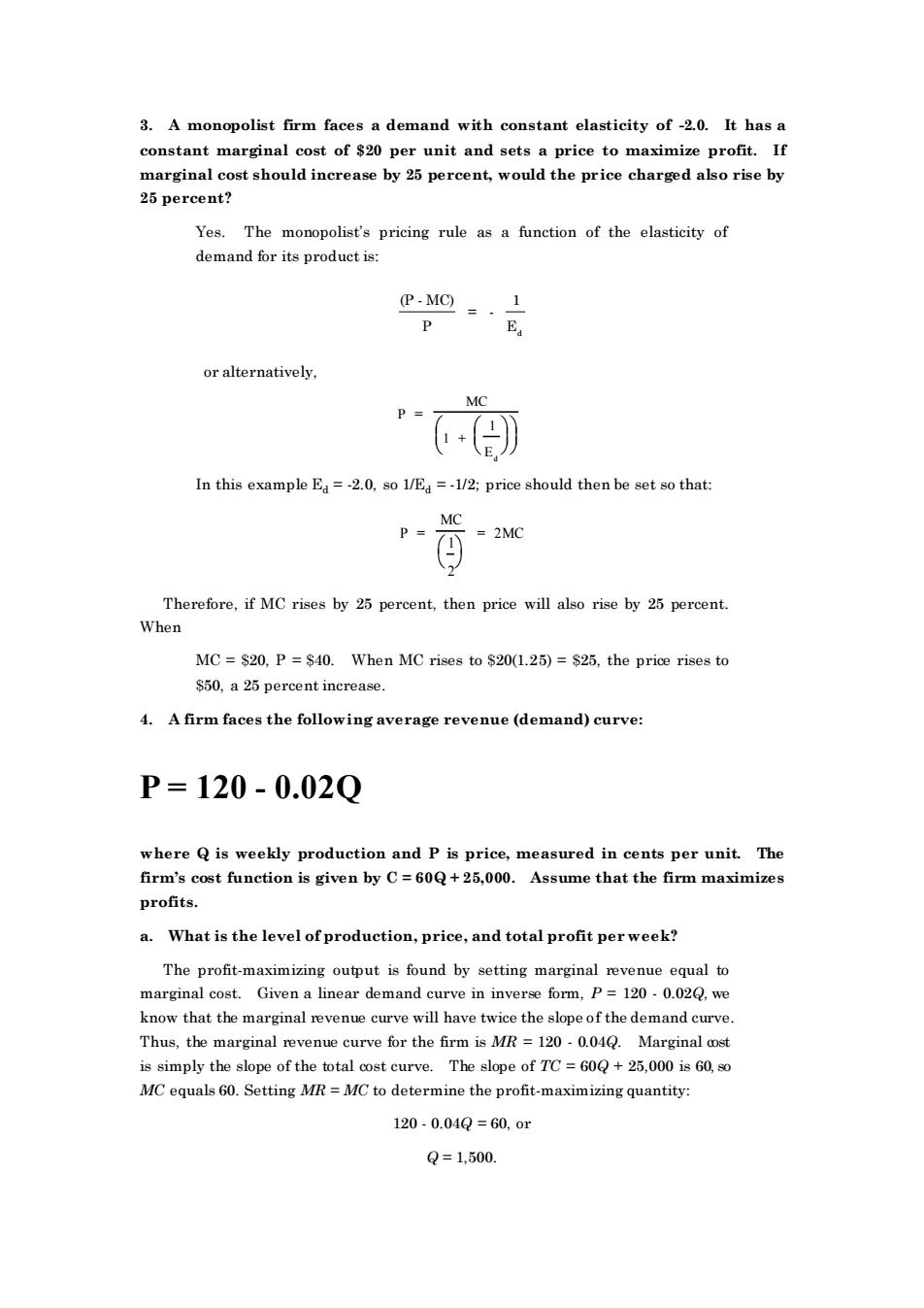正在加载图片...

3.A monopolist firm faces a demand with constant elasticity of-2.0.It has a constant marginal cost of $20 per unit and sets a price to maximize profit.If marginal Icost should increase by 25 percent,would the price charged also rise by 25 percent? Yes.The monopolist's pricing rule as a function of the elasticity of demand for its product is: or alternatively MC P=7 In this example E=-2.0.so 1/E=-1/2:price should then be set so that P= MC =2MC Therefore,if MC rises by 25 percent,then price will also rise by 25 percent When MC=$20.P=$40.When MC rises to $20(1.25)=$25,the price rises to $50,a 25 percent increase. 4.A firm faces the following average revenue(demand)curve: P=120-0.02Q where Q is weekly production and P is price,measured in cents per unit.The firm's cost function is given by C=60Q+25,000.Assume that the firm maximizes profits. a.What is the level ofproduction,price,and total profit perweek? The profit-ma四g0upu此found by sctting margina9"o mmal to margina ost Giver linear demand c rm, 20.0.02Q,we know that the marginal revenue curve will have twice the slope of the demand curve Thus,the marginal revenue curve for the firm is MR =120.0.04Q.Marginal oost is simply the slope of the total cost curve.The slope of TC=60Q+25.000 is 60.s MC equals 60.Setting MR=MC to determine the profit-maximizing quantity: 120.0.04Q=60.0or Q=1,500. 3. A monopolist firm faces a demand with constant elasticity of -2.0. It has a constant marginal cost of $20 per unit and sets a price to maximize profit. If marginal cost should increase by 25 percent, would the price charged also rise by 25 percent? Yes. The monopolist’s pricing rule as a function of the elasticity of demand for its product is: (P - MC) P = - 1 Ed or alternatively, P = MC 1 + 1 Ed In this example Ed = -2.0, so 1/Ed = -1/2; price should then be set so that: P = MC 1 2 = 2MC Therefore, if MC rises by 25 percent, then price will also rise by 25 percent. When MC = $20, P = $40. When MC rises to $20(1.25) = $25, the price rises to $50, a 25 percent increase. 4. A firm faces the following average revenue (demand) curve: P = 120 - 0.02Q where Q is weekly production and P is price, measured in cents per unit. The firm’s cost function is given by C = 60Q + 25,000. Assume that the firm maximizes profits. a. What is the level of production, price, and total profit per week? The profit-maximizing output is found by setting marginal revenue equal to marginal cost. Given a linear demand curve in inverse form, P = 120 - 0.02Q, we know that the marginal revenue curve will have twice the slope of the demand curve. Thus, the marginal revenue curve for the firm is MR = 120 - 0.04Q. Marginal cost is simply the slope of the total cost curve. The slope of TC = 60Q + 25,000 is 60, so MC equals 60. Setting MR = MC to determine the profit-maximizing quantity: 120 - 0.04Q = 60, or Q = 1,500